Unveiling the principles of solar magneto-convection
Nazaret Bello González | GAČR-DFG Weave Project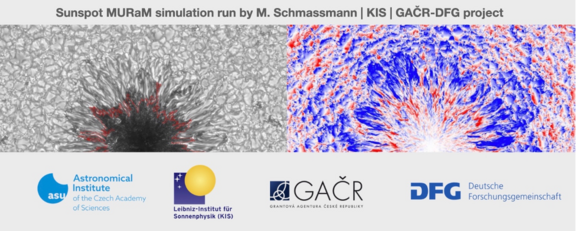
Unveiling the principles of solar magneto-convection is a joint collaboration between the Leibniz-Institut für Sonnenphysik (KIS, Freiburg), and the Astronomical Institute of the Czech Academy of Science (ASU, Ondrejov).
The project focuses on investigating the interplay between plasma and magnetic fields operating in active regions of the Sun. To this end, both high-resolution spectro-polarimetric observations and new magneto-hydrodynamic simulations of sunspots are analysed using a variety of techniques, including inversions, machine learning and statistical analysis.
This international collaboration consolidates a KIS-ASU team formed by students, post-docs and staff scientists that since 2014 have been carrying out investigations on fundamental aspects of the magneto-convective modes operating in sunspots like, e.g., the discovery of the magnetic nature of the umbral boundary in stable sunspots and the origin of the stability of the umbral mode against overturning convection.
- Funding agencies: The German Research Foundation (DFG) & the Czech Science Foundation (GAČR), through the GAČR-DFG Weave Programme
- KIS Team: Nazaret Bello González (PI), Markus Schmassmann (PhD student), Saida Díaz Castillo (Post-Doc), Rolf Schlichenmaier (Co-I) & Vigeesh Gangadharan (Co-I)
- ASU Team: Jan Jurčák (PI), José Iván Campos Rozo (Post-Doc), Marta García Rivas (Post-Doc), David Korda (Post-Doc), Michal Švanda (senior scientist) & Michal Sobotka (senior scientist)
- Collaborators: Matthias Rempel (High Altitude Observatory, US) & Iulia Chifu (Institute for Astrophysics and Geophysics, Göttingen University, Germany)
- Duration: 2023-2026
- Funds (DFG): 312,4kEUR
Highlights
The magnetic nature of the outer boundary of sunspots
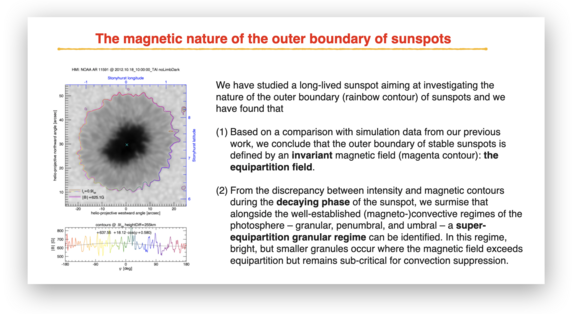
M. Schmassmann, N. Bello González, J. Jurčák & R. Schlichenmaier, A&A, accepted
Sunspot simulations with potential field initial conditions
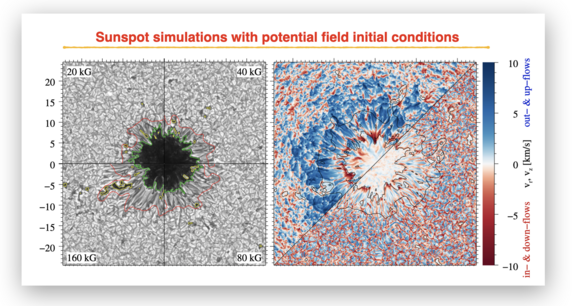
Extensive observations have been made on sunspots, but only a handful of research teams have endeavored to produce simulations that accurately reflect reality. Pioneering work presented by Rempel (2012, ApJ 750, 62) shows that realistic-looking sunspot simulations can be created. However, a recent study by Jurčák et al. (2020, A&A 638A, 28) revealed that the magnetic field distribution in Rempel's simulation, specifically the vertical field and the inclination at the umbral boundary, did not align with observations. We have created and analysed a set of sunspot simulations based on the potential-field approach aiming to replicate the magnetic and dynamic properties characteristic of observed sunspots.
Schmassmann, Bello González, Jurčák & Schlichenmaier, in prep.
Advancing the understanding of sunspot penumbra formation with non-linear force-free field extrapolations
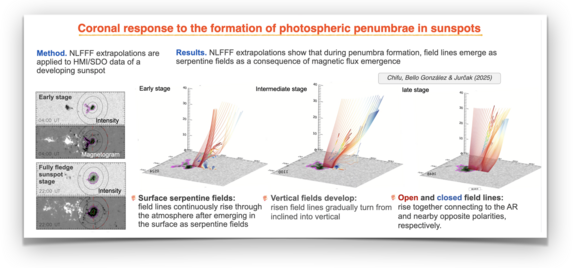
NLFFF extrapolations allow us to trace magnetic field lines throughout sunspot evolution. Serpentine fields emerge from sub-photospheric layers, anchored at the surface as moving magnetic features, and rise to inject new flux into the solar atmosphere. The formation of a magnetic canopy coincides with the appearance of the penumbra at the solar surface, supporting models that interpret penumbra formation as a flux emergence process rather than a fallen-field scenario.
Magnetic properties of the umbral boundary during sunspot decay
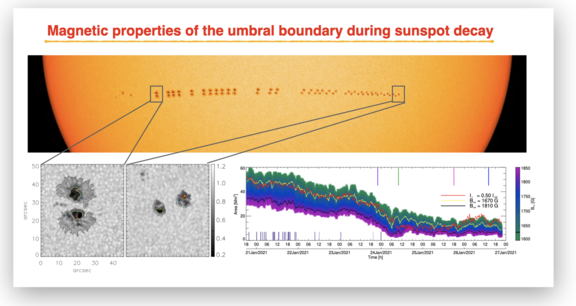
During sunspot decay, we observe a linear decrease in both area and magnetic flux. The umbra exhibits two distinct decay phases: an initial slow phase, followed by a rapid decay that coincides with the disappearance of the penumbra. Additionally, we find a 3.5-hour lag between the disappearance of the umbral vertical magnetic fields and its photometric decay.
Other publications
Average solar active region: I. Intensities, velocities, and the photospheric magnetic field
Švanda, Jurčák, Jan & Schmassmann (2025), A&A, 700, 40
Deconvolution of SDO/HMI intensity and the vector magnetic field to achieve Hinode/SOT-SP data quality
Korda, Jurčák, Švanda & Bello González (2025), A&A, 697, 28
Apparent motion of penumbral grains in a sunspot simulation
Sobotka & Schmassmann (2025), A&A, 699, 211
Onset of penumbra formation
García-Rivas, Jurčák, Bello González, Borrero, Schlichenmaier & Lindner (2024), A&A, 686, 112